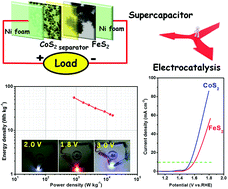Bifunctional iron disulfide nanoellipsoids for high energy density supercapacitor and electrocatalytic oxygen evolution applications†
Abstract
To solve the problem of low energy density in supercapacitor devices, enhancing the specific capacity of the anode is essential and urgent. FeS2 nanoellipsoids have been prepared using a rapid microwave-assisted method as an anode for supercapacitors. The anode possesses a wide working potential (−1.2 to 0 V), and a high specific capacity (515 C g−1 at 1 A g−1) in 2 M KOH, showing obvious improvement over conventional carbon materials used for supercapacitors. As a consequence, the maximum energy density reached 64 W h kg−1 at 271.2 W kg−1 thanks to the high specific capacity of the FeS2 anode, and the as-fabricated brand new device was able to retain 91% of its initial capacitance after 5000 cycles. Moreover, the as-prepared FeS2 ellipsoids also exhibit efficient electrocatalytic oxygen evolution in 1 M KOH with an overpotential of 370 mV at 10 mA cm−2 (vs. RHE). Therefore, the as-prepared FeS2 electrode holds huge potential for use in energy storage and conversion applications in the future.



 Please wait while we load your content...
Please wait while we load your content...